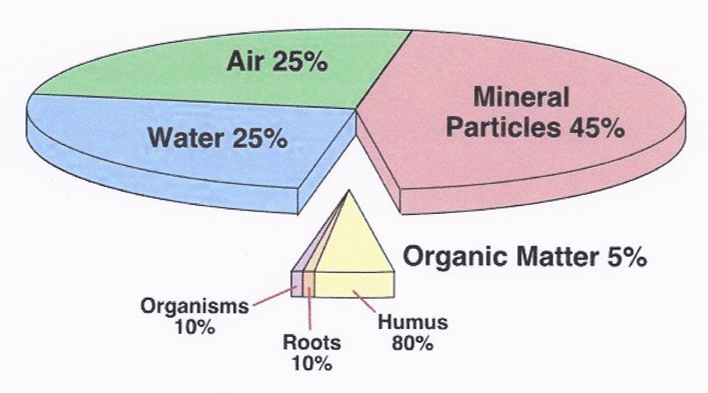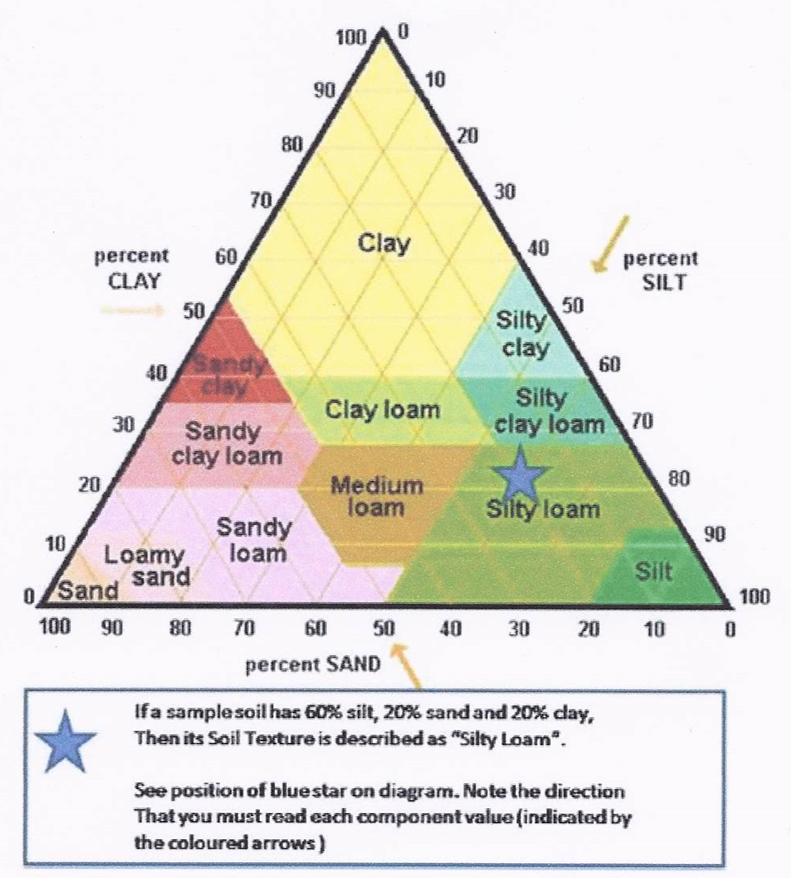
SOIL and WATER – BACK to BASICS
By Bruce Brockway, Secretary Land Drainage Contractors Association
We all know what we mean by ‘soil and water’ but it only refers to two of the three ingredients necessary for plant growth – the third being ‘air’. If you only have the first two you have a drainage problem! The purpose of drainage could be said to introduce air into soil.

Plant roots need soil, water and air to be able to absorb nutrients from the soil. As a growing medium soil should consist of roughly 50% particles, 25% water, and 25% air. The water and air should be in the spaces between the particles.

Soil Particles



Soil has mineral particles of different sizes. The smallest are clay particles, next are silt, the largest being sand. Whilst some soils can have only one size of particle like pure sand, most soils will have a mixture of particles. Soil texture is classified according to the respective percentage of these particles. For example if a soil is 60% silt, 20% sand, and 20% clay, the soil texture is described as ‘silty loam’.


Ideally an additional component in the solid portion of soil is organic matter made up of humus, roots, and organisms. This organic matter is usually only as little as 5% but it is important to give soil a structure by helping particles to clump together to form crumbs of various sizes.
The size of the spaces between these particles and crumbs, the pore space, is fundamental to the ability of a soil to either hold water or drain freely. Clay soils with lots of small pores are said to have a high porosity which means it will hold a lot of water, a more loamy soil with good organic matter will have fewer and larger pore spaces, a lower porosity, and will hold onto less water. The clay soils with small pore spaces also hold the water more tightly which means they are less permeable and drain less freely. This is why they can more easily become waterlogged. Soils with larger pore spaces, like sand, are more permeable and drain more freely.

SOIL WATER SYSTEM

The ‘Soil Water System’ introduces water to soil from rainfall. When rainfall hits the ground several things can happen to it. Some can be evaporated from the soil surface straight back up into the atmosphere. Some will run off the surface into a stream, watercourse or ditch. Some will be absorbed into the soil to be taken up by plant roots and released back to the atmosphere through transpiration of the plants be they grass, crops, or trees.
Rainfall will also be absorbed into the upper layers of the soil profile to become ‘soil water’. Beneath this upper layer water will percolate by gravity through an intermediate zone into soil at a deeper level where it becomes ‘groundwater’. The top of this groundwater level is the ‘water table’. The level of this water table can vary depending on the soil profile including type and depth of top soil, type of subsoil, and presence of any impermeable layers.
SOIL WATER

There are three types of water in soil. ‘Hygroscopic water’ surrounds, and is held tightly to the surface of soil particles. It is held so tightly, partly because of electrolytic action, that it is unavailable to plant roots. ‘Capillary water’ is held in the spaces between particles and is available to plant roots. ‘Gravitational water’ is passing between the particles draining through the soil by gravity. Eventually in a free draining soil this water will be replaced by air.
Before this gravitational water drains away all the pore spaces are full of water and the soil is said to be ‘saturated’. If the only water in the soil is the hygroscopic water unavailable to plants the soil is so dry it has reached ‘wilting point’. Between these two conditions is the ideal state and the soil is said to be at ‘field capacity’.

Thus at field capacity in a well-structured, organic, well aerated soil we have the necessary conditions for healthy plant growth.
Sadly in the case of sportsturf, in spite of the best efforts of groundsmen and greenkeepers to create and maintain these perfect conditions, we go and spoil it all by playing sport on it!
For example golf course drainage, especially of greens, would be much easier if people didn’t play golf on it! As soon as a golfer sets foot on a golf green it is compacted a little bit. The more people play golf on it the more it is compacted. When soil is compacted all the particles get squashed together so there are no spaces between them. Particularly since most soil particles are irregular or angular in shape they nestle into each other. It is these spaces which allow water to move through the soil so if there are no spaces there is no drainage. Even if a good piped drainage system has been installed, if the water can’t move through the soil to get to the drainage pipes it will not drain. This is why greenkeepers put so much effort into keeping the soil aerated to maintain a more open soil texture.

To put it into perspective a 70/30 rootzone material will have an infiltration rate of up to 800mm/hour, a normal sandy loam will be as low as 100, a clay soil only 50, but a compacted clay soil is virtually nil.
COMPACTION and INFILTRATION

Compaction combined with smearing of the surface particularly on winter games pitches, without proper maintenance will render even the best drainage system pretty ineffective.
That’s why we often hear ‘we put a drainage system in three years ago and it’s stopped working’! Perhaps it’s the maintenance that needs looking at.
WATER TABLE
It can be seen that a water table is formed in soil at the top of the saturated zone where all the pores are filled with water. Above this is the unsaturated zone of soil where the pores contain air as well as water. The level of the water table can vary. If it is at the soil surface you have a waterlogged soil, if is above the surface you have a flood!
FORMATION OF A WATER TABLE

To support plant growth the water table must be maintained below root level to give plants aerated soil conditions. The purpose of drainage is to control the level of the water table.
DRAINAGE to LOWER WATER TABLE

In drained land the level of the water table is controlled by the depth and spacing of the drains. They can either be deep and widely spaced, or shallower and more closely spaced to achieve a similar result.
DRAIN SPACING / DEPTH and WATER TABLE

The actual depth and spacing can be determined by calculation but the principle of which route you take will depend upon how quickly water needs to be drained, and how stable the soil needs to be at depth. There is clearly a cost implication too as more intensive systems will cost more.
For example agricultural drainage generally favours deep and wide spacing. Drainage is slower but provided the land dries out within a day or two after rainfall, i.e. the water table is lowered below the rootzone, plants like corn and grassland will not suffer too much in 24 to 48 hours. The drains are deep to create a low water table so that the soil is more stable at a greater depth to support heavy agricultural machinery like tractors hauling heavy trailers and harvesting machinery like combines which can compact the soil and damage soil structure in wet conditions, and damage drains if they are too shallow. So agricultural drains will often be about 1 metre deep and 20, 30, or even 40 metres apart.
EFFECT OF DRAIN SPACING ON GROUNDWATER LEVEL AND PLANT DAMAGE

In contrast, though sportsturf has the same requirement to lower the water table to prevent plant damage, it has an additional requirement for very quick surface drainage. This favours shallower more closely spaced drains. Though drains can be shallower because of the need to support lower ground pressure machinery, they are often put in at a similar depth to cater for secondary drainage, but they will generally be much more closely spaced to as little as say 10 or 5 metres on winter games pitches. For areas where surface conditions are critical such as golf greens and bowling greens, drains may be even more intensive with some systems using very shallow small diameter pipes at 500 mm spacing.
The main consideration affecting intensity of drainage on sportsturf is how quickly does the surface need to drain. If its parkland where you go to play with the kids or take the dog for walk, though good conditions underfoot are necessary, the need for quick drainage is somewhat less than say a local parish football pitch. Heavily used school playing fields may need rather more to keep them in play. With sports clubs there begins to be a financial consequence if a surface is unplayable. You eventually reach the point when because of fixture timetables, paying members or spectators, or television coverage, be it a premier league football club or a Ryder Cup venue, play has to commence on a certain day at a certain time regardless of two hours torrential rain beforehand. Clearly the need for rapid drainage is essential and a much more intensive drainage system is required in these situations. Also a higher budget!
SECONDARY DRAINAGE
Secondary drainage such as sand slits and gravel bands can further increase the rate of drainage of surface water from sportsturf. They are installed to supplement a primary piped drainage system.




It is worth stating that as the name says slits and bands are ‘secondary’ drainage – they overlay and link to a primary piped drainage system. This needs emphasising because sand slits and gravel bands are often thought to be stand alone drainage schemes. By themselves they will temporarily alleviate a surface water problem for a short while but if there is nowhere for the water to go they will soon cease to function.
Sand slits and gravel bands are installed at right angles to the pipe and intercept the permeable backfill above the pipe to provide a connection to the piped system. Their purpose is to provide a more speedy short cut for surface water to reach the piped drainage system rather than going through the soil. This is why they are sometimes referred to as ‘by-pass’ systems because they by-pass the soil, transporting surface water direct to the drainage system and thus to an outfall.
DRAINAGE LAYOUT

Traditional layout for drainage schemes was the ‘herringbone’ with a centre main drain and laterals running off it an angle like the backbone of a fish which is why it got its name.
Though it is still used, a grid system is now more common especially in sportsturf drainage. In any drainage scheme wherever there is a junction between a lateral and a main drain there is more concentration of pipe at that point and more permeable backfill over the pipe and around the junction. Hence there is a higher rate of drainage at that point which results in uneven plant growth. In some situations this doesn’t matter but in sportsturf if you use a herringbone layout with the main drain running down the centre of a pitch, or fairway, this uneven grass growth will be clearly visible in certain conditions. So aesthetically it is not pleasing, also it is more expensive in time and materials because there are more junctions and shorter runs of laterals for a given area.
This is why a grid system is more common for sportsturf areas. The main drain can be positioned off the playing surface. For pitches this can be beyond the side-line, for golf courses this can be at the side of a fairway or off the green. Laterals then form a grid across the playing surface into the main.
One common misconception about drainage is that it is supposed that drains should run downhill! Yes they should have a slight fall of something around 1in 100 and this is called the ‘grade’ of the drain. But on sloping ground they should not run downhill to follow the lie of the land. Instead laterals should run across the slope following the contours of the land. Effectively each lateral then becomes an interceptor drain reducing the amount of water moving down the slope. This is why you can have the strange phenomenon of a main drain appearing to be on the high ground. On the high side of a fairway for example where even the main drain can also be an interceptor.
Interceptor, or cut off drains such as ditches, swales, and french drains, can have an important role as part of a drainage scheme. Most soils become waterlogged due to groundwater, but there are many cases where land is wet due to surface run off from land at a higher level. The installation of an interceptor drain to catch the water before it runs downhill may in some cases alleviate the problem to the extent that no drainage, or much less drainage is necessary at the lower level.
FINALLY
There are two things to establish before starting to drain – where is the water coming from, i.e. the cause of the problem, and where is it going to go to – the outfall?


Comments are closed, but trackbacks and pingbacks are open.